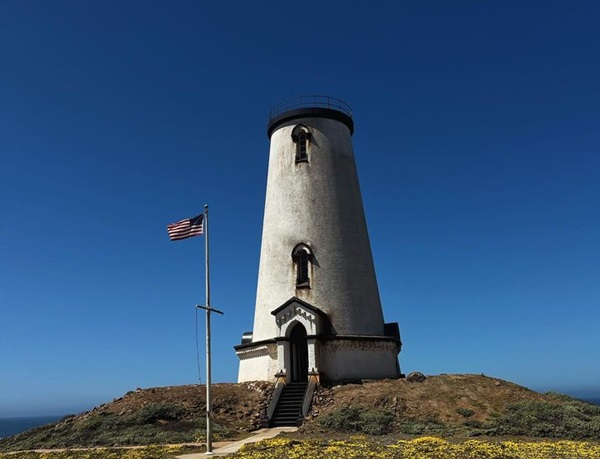
Photo courtesy Piedras Blancas Lighthouse and Preserve Facebook page.
Nearly 150-year-old beacon of history welcomes visitors
—The Piedras Blancas Light Station, first illuminated in February 1875, is a historic landmark and wildlife sanctuary, managed by the United States Bureau of Land Management (BLM) and the Piedras Blancas Light Station Association (PBLSA). The tower and some of the buildings are listed on the National Register of Historic Places.
In 2017, President Barack Obama expanded the California Coastal National Monument to include Piedras Blancas and more than 6000 acres along the coastline for 1100 miles. The expansion includes sites in Mendocino, Humboldt, Santa Cruz, San Luis Obispo, and Orange Counties.
A visit to the Piedras Blancas Light Station is a glimpse into the past when lighthouses were a vital necessity for safe maritime navigation. Lighthouses and earlier beacons of fire built on high places along the shore to warn sailors of dangerous waters or to mark entries to ports have a long history as long ago as the ancient Egyptians. The mysterious sound of the booming foghorn and beacon glowing through darkness and storms has taken a mysterious place in the imaginations of everyone, sailor, or not. Who hasn’t thought, at least once, that it might be fun to live in a lighthouse, even for a weekend?

Take in stunning views of the Central Coast while walking through the pathways of the Piedras Blancas Light Station.
Even though the Piedras Blancas lighthouse today is only 70 feet tall today, reduced from its original 100 feet height, a visit still stirs the imagination of being at sea on a stormy, starless night, watching for that beacon. The missing three levels, which held a fourth-floor landing, the watch room, and the original Fresnel lens, were removed in 1949 after earthquake damage the year before. The lens is currently housed in an enclosure on Main Street in Cambria for public view. The enclosure has degraded over time, and the roof has been damaged by recent storms.
Restoration of the original floors is underway. Volunteers have worked more than 100,000 hours restoring the lighthouse and surrounding buildings. The fuel oil house has been restored and a replica of the station’s shingled watch room has been completed in addition to other historic structures. The Piedras Blancas Light Station Association gift shop is housed in what once was a strip of small offices.
The light station is named for the white rocks just offshore. The park occupies ocean-side land six miles north of Hearst Castle on Highway 1. Visitors can experience a variety of sea birds, sea lions, and elephant seals along with other wildlife that lives in the area. Over 70 native California plant species have been identified with interpretive signs. For many years the area was overgrown with Carpobrotus, the invasive ice plant still growing in other locations in California. Volunteers worked long and hard pulling out this invasive plant and, miraculously, the native vegetation began to return on its own.
The Piedras Blancas Light Station is located at 15950 Cabrillo Highway (HWY1), in San Simeon, CA. Tours are by reservation only and start at 9:45 a.m. on the designated days. For seasonal tour schedules, tickets, and more information visit piedrasblancas.org or call (877) 444-6777.











